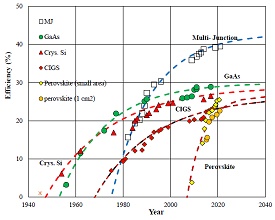Volume 66, Issue 2
Special Feature : Next Generation Solar Cells for Achieving Carbon Neutrality
Displaying 1-14 of 14 articles from this issue
- |<
- <
- 1
- >
- >|
Preface
-
Article type: Preface
2023 Volume 66 Issue 2 Pages 77
Published: February 10, 2023
Released on J-STAGE: February 10, 2023
Download PDF (368K)
Special Feature : Next Generation Solar Cells for Achieving Carbon Neutrality
-
Article type: Overview
2023 Volume 66 Issue 2 Pages 78-85
Published: February 10, 2023
Released on J-STAGE: February 10, 2023
Download PDF (2932K) -
Article type: Current Topics
2023 Volume 66 Issue 2 Pages 86-90
Published: February 10, 2023
Released on J-STAGE: February 10, 2023
Download PDF (4929K) -
Article type: Current Topics
2023 Volume 66 Issue 2 Pages 91-96
Published: February 10, 2023
Released on J-STAGE: February 10, 2023
Download PDF (3987K) -
Article type: Current Topics
2023 Volume 66 Issue 2 Pages 97-102
Published: February 10, 2023
Released on J-STAGE: February 10, 2023
Download PDF (789K) -
 Article type: Current Topics
Article type: Current Topics
2023 Volume 66 Issue 2 Pages 103-108
Published: February 10, 2023
Released on J-STAGE: February 10, 2023
-
Article type: Current Topics
2023 Volume 66 Issue 2 Pages 109-113
Published: February 10, 2023
Released on J-STAGE: February 10, 2023
Download PDF (7203K)
Current Topic
-
Article type: Current Topics
2023 Volume 66 Issue 2 Pages 114-119
Published: February 10, 2023
Released on J-STAGE: February 10, 2023
Download PDF (1826K)
Science Café
Award winner
-
Article type: Science Café
2023 Volume 66 Issue 2 Pages 120
Published: February 10, 2023
Released on J-STAGE: February 10, 2023
Download PDF (655K) -
Article type: Science Café
2023 Volume 66 Issue 2 Pages 121
Published: February 10, 2023
Released on J-STAGE: February 10, 2023
Download PDF (376K) -
Article type: Science Café
2023 Volume 66 Issue 2 Pages 122
Published: February 10, 2023
Released on J-STAGE: February 10, 2023
Download PDF (566K)
Report
Conference Report
-
Article type: Report
2023 Volume 66 Issue 2 Pages 123
Published: February 10, 2023
Released on J-STAGE: February 10, 2023
Download PDF (713K) -
Article type: Report
2023 Volume 66 Issue 2 Pages 124
Published: February 10, 2023
Released on J-STAGE: February 10, 2023
Download PDF (680K)
News & Trends
-
Article type: News & Trends
2023 Volume 66 Issue 2 Pages 125
Published: February 10, 2023
Released on J-STAGE: February 10, 2023
Download PDF (359K)
- |<
- <
- 1
- >
- >|







